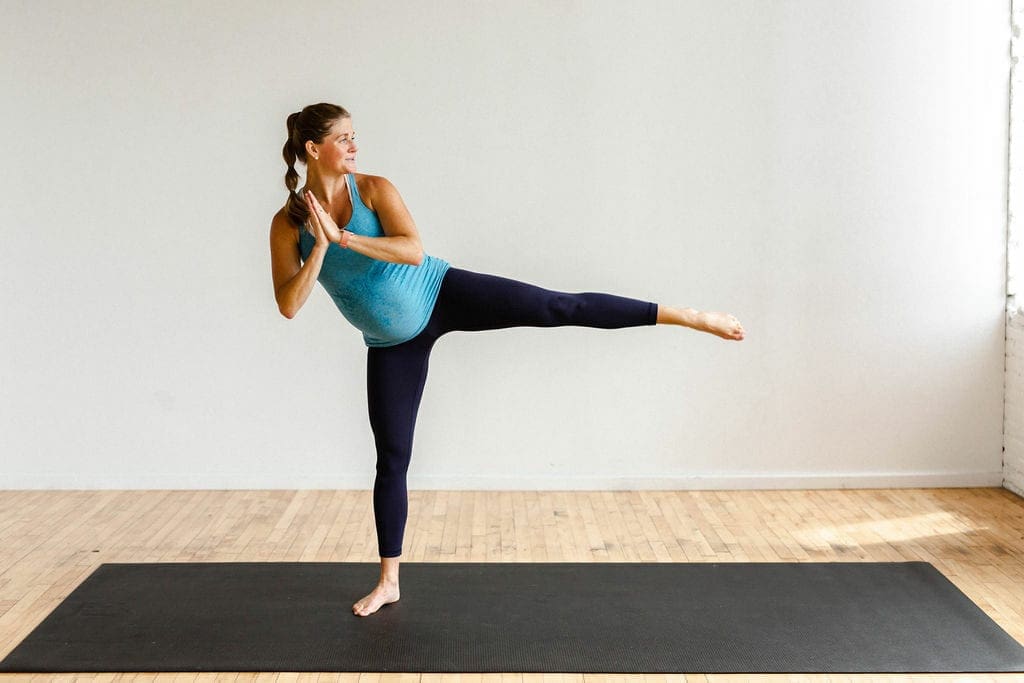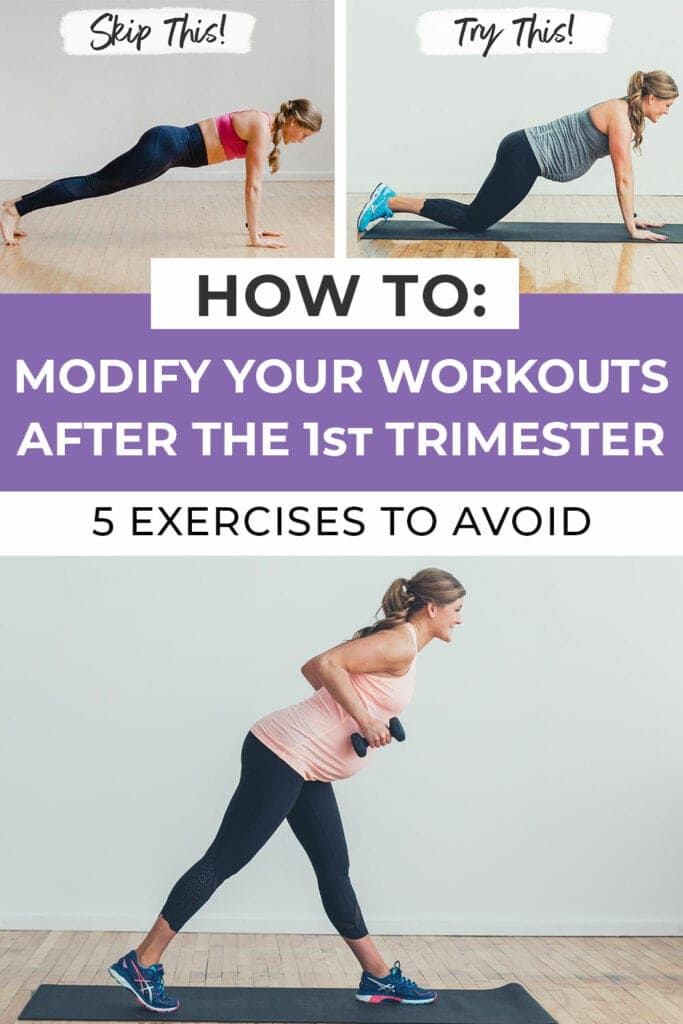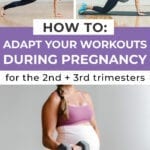

5 Exercises To Avoid During Pregnancy {+ pregnancy-safe modifications}
Pregnancy workouts have health benefits for both mom and baby — but there are some exercises that should be avoided during pregnancy; specifically during the second and third trimesters as your baby bump grows. Here are 5 exercises I personally avoid during pregnancy, and accompanying modifications to make these exercises safe for pregnancy.
Exercise during pregnancy…there are SO MANY mixed messages out there. As a new mom it can be confusing as to what exercises are safe for pregnancy?
And what exercises should be avoided during pregnancy? And when do you start modifying exercises for pregnancy?
To be honest, there’s not a ‘one-size’ fits all answer for this because every body and every pregnancy can be so different.
That said, if you were physically active and exercised regularly before getting pregnant, maintaining a fitness routine during pregnancy can be a wonderful way of reducing the aches and pains of a growing baby bump. Not to mention, exercise during pregnancy prepares for the greatest workout of all — labor and delivery!
In general, pregnancy workouts are beneficial not only for expecting moms, but for baby as well!
Exercise during pregnancy can help reduce backaches, help you sleep better, and lower the risk of gestational diabetes {Mayo Clinic}. There’s also some research that indicates that an active pregnancy provides a boost to baby’s brain and heart health as well {What To Expect}.

In this post I’m highlighting 5 exercises I avoid during pregnancy; specifically during the second and third trimesters of pregnancy.
Note, I suggest you consult your doctor or midwife to make sure you are cleared to exercise during pregnancy.
As I mentioned above each pregnancy is different; I started modifying my workouts much sooner in my second pregnancy.
My belly grew faster and I came into my second pregnancy with diastasis recti (abdominal separation), so I experienced ‘doming’ of my abdomen much earlier in my pregnancy. You can read more about signs it’s time to modify your workouts , like ‘doming’ of your abdomen, in this post.

5 Exercises to Avoid During Pregnancy + Safe Modifications
1. Upward Facing Dog, Deep Back Bends + Abdominal Overextension

Why avoid upward facing dog, deep back bends and abdominal overextension during pregnancy:
While gentle backbends can can feel great during pregnancy, I avoid deep backbends like upward facing dog (pictured above) or upward bow pose unless you have been safely and comfortably practicing them pre-pregnancy.
These movements can cause an over stretching of the abdominal muscles, which can put you at a higher risk for diastasis recti (abdominal separation), and can make diastasis recti worse if you already have some abdominal separation. Since I came into my second pregnancy with diastasis recti these are moves I avoided.
How to modify upward facing dog, deep back bends and abdominal overextension for pregnancy:
Instead try reverse table top top to open up the front of the body. Or if I’m taking a yoga class, I’ll skip upward facing dog and go straight from modified plank, to modified chauturunga, to downward dog.
2. Pull Ups

Why avoid pull ups during pregnancy:
I love doing pull ups for strength training when I’m not pregnant; they are an effective total body strength exercise. But I stopped doing pull ups pretty early into pregnancy, around 16-18 weeks pregnancy, for a few reasons:
- Pull ups require a lot of core engagement. Meaning the added weight of your growing belly makes pull ups much more difficult. And the core engagement required to perform a pull up can put you at increased risk of diastasis recti.
- Pull ups are an extremely challenging exercise. Which means you often ‘bear down’ and/or hold your breath to complete a pull up which is something you want to avoid during pregnancy workouts.
How to modify pull ups for pregnancy:
If you have access to a gym, the lat pull down machine is a great option to replace pull ups. But there are several other back exercises that are safe for pregnancy, such as: dumbbell back flies, single and double arm dumbbell back rows, and TRX rows.
3. Standard Crunches + Twisting

Why avoid crunches and abdominal twisting during pregnancy:
During pregnancy you want to give baby as much room as possible. It’s a good practice to avoid compressing the abdomen during pregnancy.
Traditional crunches compress and limit the amount of space baby has to move around.
Twisting motions have a similar affect of compressing the abdomen and should be avoided during pregnancy. Some twisting yoga postures to avoid outside of a seated abdominal twist include — twisting chair, twisting crescent, revolved triangle, and revolved half moon.
How to modify crunches and abdominal twisting for pregnancy:
This is kind of hard to explain, so I recommend watching the video at the top of this post for a full demonstration of this pregnancy core exercise (featured around minute 2).
Basically, you can safely engage your core muscles from a seated position, commonly referred to as ‘boat pose’ (pictured above). Lean slightly back and make small, 1″ movements forward and back. If you need additional support place a pilates sponge ball or squish kids toy ball where your low back meets the mat. Additionally, you can add arm opens and/or heel taps for extra challenge.
4. Plank on Toes

Why avoid planks during pregnancy:
I was still planking on my toes well into my second trimester with my first pregnancy. But I came into my second pregnancy with 1-2 finger diastasis recti ab separation which required me to modify my planks a lot sooner.
You know it’s time to start modifying your planks when you begin to experience ‘doming’ of the abdominal muscles during plank poses. For more details reference this post. Ultimately, you want to avoid any kind of exercise that causes your belly to ‘dome or cone’ because that can cause further ab separation, or diastasis recti.
Note, this also mean modifying exercises that are plank-based, such as — push ups, dumbbell plank and row or renegade rows, and side planks.
How to modify planks for pregnancy:
Dropping to your knees is a great way to modify any kind of plank-based exercise. It alleviates a lot of the pressure on your abdominal muscles while still allowing you to safely engage your core and deep transverse abdominal muscles.
If you need to modify further, drop to table top on all fours with your hips stacked over your knees and shoulders stacked over your wrists. From this table top position you can perform cow posture to again engage your deep transverse abdominal muscles.
5. Lying on Stomach + Belly Down Postures

Why avoid lying on your stomach and belly down postures during pregnancy:
This one’s pretty intuitive — laying on your stomach simply isn’t comfortable once your baby bump starts appearing (typically towards the end of your first trimester, ~8-12 weeks). You want to avoid any exercises or yoga poses that involve lying or placing pressure directly on your belly. Examples of these exercises include cobra pose in yoga, or superman exercises.
How to modify lying on your stomach and belly down postures for pregnancy:
Similar to planking, you can drop to table top position on all fours with your hips stacked over your knees and shoulders stacked over your wrists. From this table top position you can perform exercises such as birddog (pictured above).
Additionally, as your belly continues to grow into your second and third trimesters you may have to take certain exercises, like push ups, to an incline position to avoid hitting the ground with your stomach.
In addition to the 5 exercises to avoid during pregnancy above, general guidelines for safe exercise during pregnancy include:
- Heart Rate — your heart is working faster and harder during pregnancy to get oxygen to both you and baby. You may feel your heart rate rise faster than you’re used to, and you want to avoid over-exerting your heart rate. A good rule of thumb is to imagine a scale of exertion, levels from 1 to 10. If 10 is the hardest, and 1 is the easiest, we want to stay around a level 6, and go no greater than a level 7 during pregnancy workouts.
- Difficulty of Pregnancy Workouts — pregnancy isn’t the time to be pushing your body to do the hardest workout you’ve ever done. A resource is the ‘talk test’: you want to be able to hold a conversation with someone, without getting out of breath, for the duration of the workout.
- Muscle + Joint Pain — muscle and joint pain are common pregnancy complaints. If you’re experiencing muscle or joint pain, avoid high impact exercises and switch to low impact workouts. Continuing to move, striving for 10,000 steps a day, tends to keep muscle and joint pain away.
- Take a Wider Stance — naturally as your baby bump grows your stance will also widen for exercises like squats and forward folds. It’s important to always make room for baby and protect your low back by widening your stance. Additionally, you can add yoga blocks assist as needed.
- Inversions — I’m not much of an inversion person myself, but the general rule is if you didn’t have a strong inversion practice before you got pregnant, now is not the time to start. The most obvious risk includes toppling over, but other risks include confusing baby in the third trimester, if baby is head down, avoid flipping baby breech with inversions.
Note: every pregnancy is different. If you have any concerns, or if you’re starting a fitness program for the first time, please consult your doctor or midwife. As always listen to your body.

At-Home Pregnancy Workouts
CLICK HERE to access all of my FREE Pregnancy Workouts on the blog!
Additionally, I filmed a Facebook Live video you can find linked in this post in which I go into more detail on:
- Pregnancy Safe Ab Exercises and Prenatal Ab Exercises
- Ab Exercises to Avoid During Pregnancy
- Transverse Abdominal Breathing and How to Strengthen Your Transverse Abdominals
- Ab Exercises You Can Do While Sitting At Your Desk
- Pelvic Floor Exercises for Women and How to Connect Your Pelvic Floor to Your Transverse Abdominals
- What is Diastatic Recti and What Ab Exercises Are Safe for Diastatic Recti
Pin these 5 Exercises To Avoid During Pregnancy




















